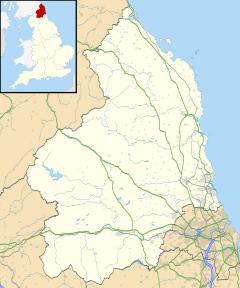world.wikisort.org - United_Kingdom
Woodhorn is a village and former civil parish, now in the parish of Newbiggin by the Sea, in Northumberland, England, about 2 miles (3 km) east of Ashington. In 1931 the parish had a population of 219.[1] The village is sometimes identified with Wucestre, given to St Cuthbert by King Ceolwulf when he gave up his throne in 737 to become a monk at Lindisfarne. A medieval bell at Woodhorn, inscribed "Ave Maria", is said to be one of the oldest in existence.[2]
| Woodhorn | |
|---|---|
 Woodhorn Location within Northumberland | |
| OS grid reference | NZ2958 |
| Civil parish |
|
| Unitary authority |
|
| Ceremonial county | |
| Region | |
| Country | England |
| Sovereign state | United Kingdom |
| Post town | ASHINGTON |
| Postcode district | NE63 |
| Dialling code | 01670 |
| Police | Northumbria |
| Fire | Northumberland |
| Ambulance | North East |
| UK Parliament |
|
Governance
On 1 April 1935 the parish was abolished and merged with Newbiggin by the Sea and Ashington parishes.[3]
Economy
The main employment was at the coal mine. The mine has since closed and the site has been landscaped incorporating a lake and known as Queen Elizabeth II Country Park. Some of the mine buildings have been retained and are used as a visitor centre.
Landmarks
Woodhorn Colliery Museum is situated in a country park with a 40-acre (16 ha) lake. With sound effects, models, paintings, working machinery etc., the museum gives an insight into life in a local coal-mining community.[2]
The site of the old pit is now the location for Northumberland Record Office, a purpose-built building having been constructed to replace the two previous buildings at Morpeth and Gosforth.
Religious sites
The church is dedicated to St Mary.[4]
References
- "Population statistics Woodhorn AP/CP through time". A Vision of Britain through Time. Retrieved 29 January 2022.
- "Linden Hall". Retrieved 11 December 2008.
- "Relationships and changes Woodhorn AP/CP through time". A Vision of Britain through Time. Retrieved 29 January 2022.
- Purves, Geoffrey (2006). Churches of Newcastle and Northumberland. Stroud, Gloucestershire, England: Tempus Publishing Limited. p. 178. ISBN 0-7524-4071-3.
External links
![]() Media related to Woodhorn at Wikimedia Commons
Media related to Woodhorn at Wikimedia Commons
- GENUKI (Accessed: 27 November 2008)
- Experience Woodhorn[Usurped!] (Woodhorn colliery museum and country park, and the Northumberland archives)
Другой контент может иметь иную лицензию. Перед использованием материалов сайта WikiSort.org внимательно изучите правила лицензирования конкретных элементов наполнения сайта.
WikiSort.org - проект по пересортировке и дополнению контента Википедии